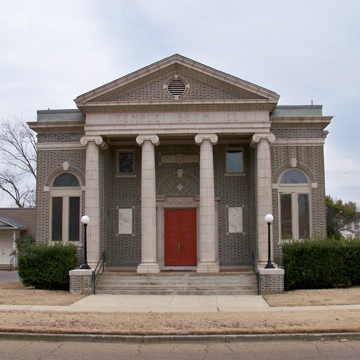Helena is home to one of the oldest Jewish communities in the state, dating back to the 1840s. The community continued to grow in the 1850s as Jews from central Europe, mostly Prussia, settled here as well as in towns along both sides of the Mississippi River. Formed in 1867, the congregation first met in the members’ homes, in a rented space on Ohio Street, and in a former church until they completed their first synagogue in 1880. That brick structure was replaced by this Classical Revival building in 1916. The one-story building of gray brick has a portico of four fluted Ionic columns and a pediment. Helena’s Jewish population decreased later in the twentieth century, and in 2006 the few remaining members of the congregation decided to close and deconsecrate their temple and donate it to the State for use as another component of the Delta Cultural Center. There were few synagogues in this region, and fewer still are extant, which gives this fine building added importance.
You are here
Historic Temple Beth El, Delta Cultural Center
If SAH Archipedia has been useful to you, please consider supporting it.
SAH Archipedia tells the story of the United States through its buildings, landscapes, and cities. This freely available resource empowers the public with authoritative knowledge that deepens their understanding and appreciation of the built environment. But the Society of Architectural Historians, which created SAH Archipedia with University of Virginia Press, needs your support to maintain the high-caliber research, writing, photography, cartography, editing, design, and programming that make SAH Archipedia a trusted online resource available to all who value the history of place, heritage tourism, and learning.















